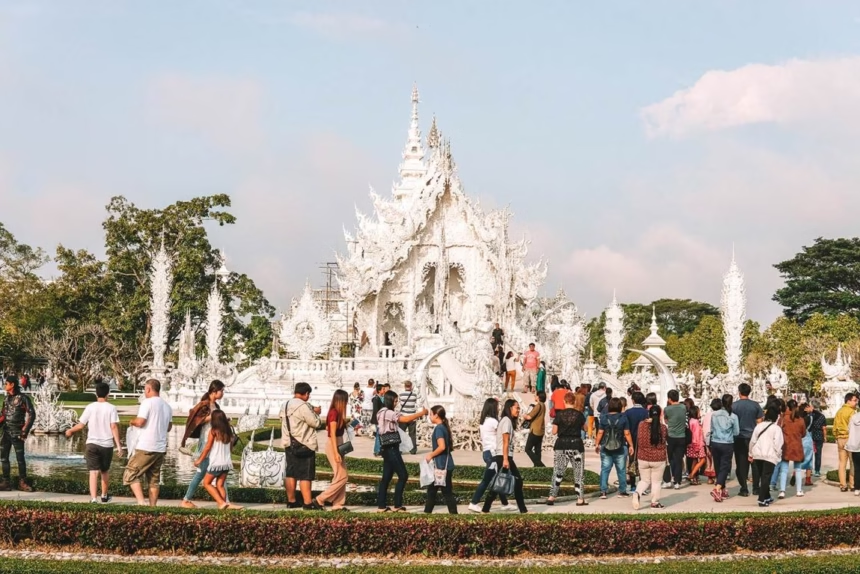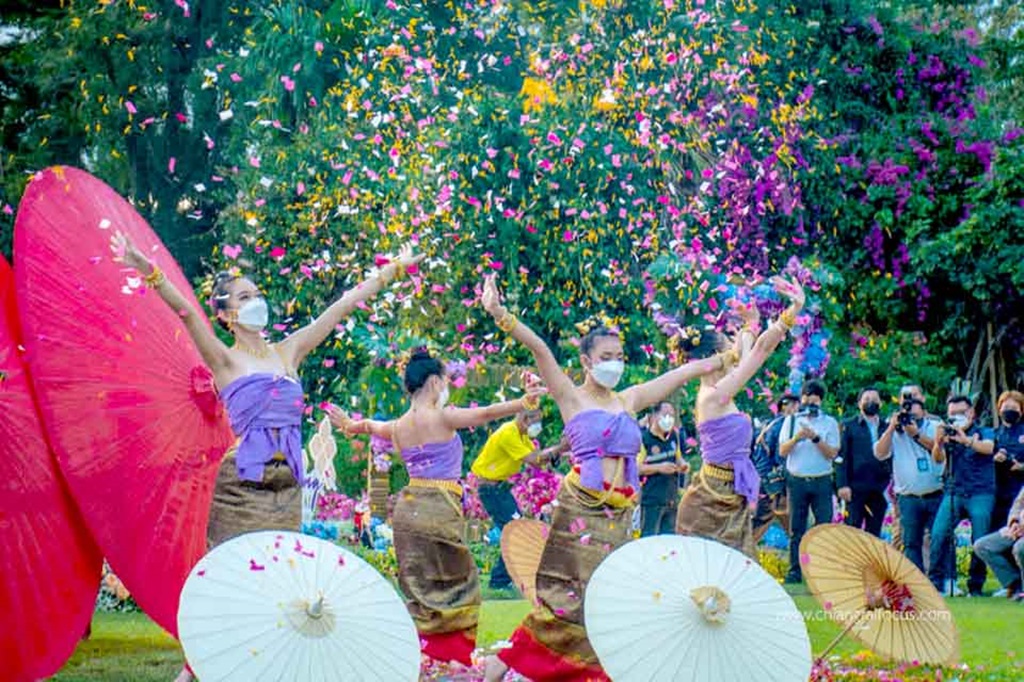CHIANG RAI– In the cool hills of northern Thailand, where the Mae Fah Luang Gardens are in bloom all year and the Mekong carries old trade stories, tourism is more than business. It supports families and local pride in places like Chiang Rai.
As November settles over the Golden Triangle, the Association of Thai Travel Agents (ATTA) and the Thailand Convention and Exhibition Bureau (TCEB) have presented a set of strong proposals to steady the tourism sector. With foreign arrivals lagging and global uncertainty lingering, the plans promise recovery and long-term strength, giving northern provinces such as Chiang Rai a chance to shine.
The proposals, launched at a joint forum in Bangkok, arrive at a sensitive moment. Thailand’s post-pandemic rebound has slowed. Chinese arrivals fell 34 percent in the first half of 2025, safety worries linked to regional scams have spread, and a strong baht has weakened price appeal against Vietnam.
ATTA expects only 32 million international visitors this year, well below the 40 million official goal. TAT now projects 2.66 trillion baht in revenue, a 5 percent slip from 2024. Still, hope remains. “Chiang Rai’s hill tribes and organic farms aren’t just attractions; they’re antidotes to overtourism,” says local tour operator Naree Laopattarakit, sharing the view that secondary cities can balance growth.
ATTA’s Plan: Flight Support, Safety Uptick, and Wider Markets
ATTA, which represents Thailand’s travel agents, has set out a detailed package. President Thanapol Cheewarattanaporn proposes urgent flight support, led by a 350 million baht fund for 1,000 charter flights from secondary Chinese cities such as Chongqing and Lanzhou.
The goal is to attract first-time, high-spending visitors who could inject 33.5 billion baht into the economy. “We’ve lost 56 percent of organised Chinese groups since January,” Thanapol says, citing safety fears tied to scam hubs in Cambodia. “With subsidies up to 350,000 baht per flight, we can draw 790,000 visitors by year-end.”
Safety sits at the centre of ATTA’s approach. The association suggests positioning Thailand as an ASEAN Safety Hub, with cross-border agreements with Laos and Cambodia to disrupt criminal networks, plus a Safe ASEAN Travel Desk for real-time alerts. The idea carries weight in Chiang Rai, where borders bring risk and potential.
“Tourists hesitate at the Golden Triangle checkpoints,” says Chiang Rai Tourism Association head Boonmee Srisuk. “ATTA’s joint protocols could turn our tripoint into a secure gateway, not a worry spot.” Alongside this, a 20 million baht “Sawadee Nihao” campaign would host 300 Chinese tour operators and influencers on VIP trips. An 800 million baht push with online travel agencies would offer discounts of up to 1,500 baht, targeting 950,000 arrivals and 7.2 billion baht in bookings.
ATTA also wants to diversify source markets and products. A large B2B event in January 2026 will build multi-country packages, pairing Thai beaches with Laos’ temples and Vietnam’s river journeys. At home, ATTA aims to spotlight “Hidden Gems” such as the White Temple and Doi Tung’s royal projects, promoting weekday breaks to smooth demand.
Honorary President Sisdivachr Cheewaratanaporn supports ultra-luxury campaigns, with a 120 million baht influencer drive seeking 500 million impressions and targeting wellness seekers in the northern hills. “Volume got us here; value will sustain us,” he says, backing Abhisit Vejjajiva’s five-point Democrat Party roadmap, which ATTA endorses. The plan includes a Tourism Trust Mark for ethical operators and regional boards that give more say to places like Chiang Rai.
ATTA TCEB tourism proposals
While ATTA focuses on leisure travel, TCEB is pushing business events to anchor high-spend tourism. The “Thailand Power Up” campaign, co-launched with TAT, offers tax perks and incentives for MICE between October 2025 and July 2026, with a focus on long-haul groups from Europe and the Middle East. “MICE is recession-proof,” says TCEB President Supawan Teerarat. “Even as leisure dips, we’re hosting Amway China’s 13,000-delegate seminar next year, proof our ecosystem thrives.”
TCEB’s plan highlights infrastructure and smart incentives. Quick steps include hybrid trade show support for India and Gulf markets, aiming to draw more than 10,000 delegates to events such as the IMF-World Bank gathering. On the R3A route, which links Kunming to Bangkok, TCEB sees MICE hubs across Isan and the North, with Chiang Rai as a cultural stop.
“Our 5-Year MICE Master Plan brings in soft power, like Muay Thai incentives in Phuket and eco-conferences in Chiang Mai,” Supawan says. A headline bid is support for Nakhon Ratchasima to host the 2029 International Horticultural Expo under the “Nature and Greenery” theme, expecting 4 million visitors and green-tech showcases that could inspire eco-festivals in the North.
Sustainability threads through TCEB’s agenda, backed by a Letter of Intent with 20 partners, including ATTA and TAT, to meet UN-aligned Sustainable Tourism Goals by 2030.
Tools such as the STGs STAR Rating will accredit carbon-neutral venues, from Bangkok’s BITEC to emerging convention sites in Chiang Rai. “We’re not just hosting events; we’re hosting futures,” Supawan says, with workshops planned in Chiang Rai this October to train locals in green MICE practices.
Northern Prospects: What Chiang Rai Stands to Gain
For Chiang Rai, the proposals feel close to home. The province, which draws about 1.2 million visitors a year, could benefit from TAT’s “Amazing Thailand Grand Tourism Year” links. The Passport Privileges campaign will hand out “Amazing Bags” of discounts at airports from November, with an expected 400 million baht in nationwide spend.
Northern festivals, including Diwali and Loy Krathong upgrades, could attract 100,000 visitors from India. There are hurdles. Crowding at Doi Suthep threatens the visitor experience, and the strong baht is cooling demand from Russian travellers who once favoured the highlands.
Local leaders are keen. “ATTA’s subsidies mean more charters to Mae Fah Luang Airport, TCEB’s MICE could fill our hotels mid-week,” says Chiang Rai Governor Narongsak Osatanon. Community-based tourism offers ideas worth copying.
Borsuak Village’s UN-recognized eco-tourism in Nan shows the way, from Akha weaving workshops to virtual reality previews under ATTA’s digital push. With Minister Atthakorn Sirilatthayakorn’s “Big Impact Act Fast” policy rolling out, including 90-day visas for long-haul high-spenders and SEA Games preparations in December, Chiang Rai is targeting 10 percent growth, with benefits reaching 500 hill tribe households.
 A Shared Route Ahead: From Setback to Celebration
A Shared Route Ahead: From Setback to Celebration
ATTA and TCEB do not claim to have all the answers, but they are calling for united action. With TAT’s 6.23 billion baht budget boosting major events such as the Amazing Thailand Countdown, which sets aside 25 million baht for Chiang Mai, these plans could help close the eight million-arrival gap.
Analysts such as Gary Bowerman warn that passing 40 million has a psychological weight, a signal that pandemic scars are healing. Abhisit argues for better governance, with more power devolved to regional clusters like the North, to spread gains fairly.
On lantern-lit nights in Chiang Rai, as Loy Krathong floats drift downstream, confidence grows. The real measure of tourism is not just the numbers, it is the smiles at a street food stall and the applause at a MICE gala under Doi Tung’s palms.
As 2025 draws to a close, Thailand’s invitation is clear, warm and ready. Will the Cabinet approve these plans? For people across the North, that decision cannot come soon enough.








 A Shared Route Ahead: From Setback to Celebration
A Shared Route Ahead: From Setback to Celebration








